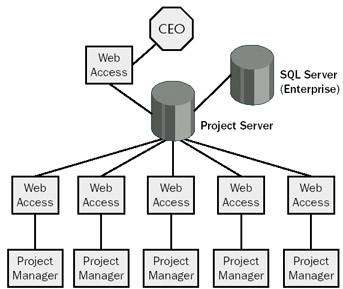Modeling Enterprise Implementations
Because the components are designed to be flexible and scalable, there are probably hundreds of ways in which your organization can implement enterprise project management through Project Professional. The style of the implementation your organization adopts depends largely on your organization's structure and management practices. This section includes three implementation examples, based on modern organizational structures.
Implementing a Pyramid Hierarchy
One example of a straightforward project enterprise implementation is the classic pyramid hierarchy model (see Figure 20-4) with a single top point and more connections the further you go down, from CEO to project team member.

Figure 20-4: You can implement enterprise projects in a classic pyramid hierarchy.
For example, imagine a software development company with five different projects in progress at the same time. The project managers all use Project Professional to manage their projects. Project Server is installed in the central data systems office, along with SQL Server. Each of the five projects has ten team members connected through the Project Server. The CEO of the company has an executive account set up to work with Project Server with Web Access.
The five project managers publish their enterprise project and resource information through Project Server. Their team members and stakeholders use Project Web Access to see their pertinent project information and collaborate effectively. The CEO uses the enterprise account to see and evaluate all the projects in the company in a standardized form and view and analyze all the resources in the company.
Implementing a Tapered Block Hierarchy
A second example involves larger organizations that have dozens of projects being worked on at a given time. This type of implementation is more of a tapered block model of information exchange and access.
In the tapered-block model, there are multiple sources of information at the project level and there are multiple (though fewer) connections at the upper enterprise level. This model is effective for large, discretely organized firms, such as telecommunications companies, which make executive decisions based on input from department heads.
For example, suppose that each of the projects is using Project Professional. Project Server is set up for enterprise features, and all the project managers publish their enterprise project and resource data to Project Server. At the enterprise account level, ten vice presidents connect to their Project Server accounts, in which they view and analyze project and resource information, focusing on the projects that are most important to them. They then advise and inform the company president.
Implementing a Straight Block Hierarchy
A third example is a company that uses a pure project management model for its organization. Some construction companies are set up in this way. This model is considered a straight block . The level of authority and responsibility below the president is the project manager. All the work in the company is planned, performed, and tracked as projects.
For example, suppose that there are 12 different projects being done, each independent and equal in importance to the company. The 12 project managers all use Project Professional and all are connected to Project Server, which is set up for enterprise project management. All project managers and the company president have enterprise accounts. They see the resource and project information about all or selected projects among the 12. They can quickly resolve prioritization and utilization issues by using the enterprise features. The president also can see the entire company's work and resources in a standardized manner.
EAN: 2147483647
Pages: 268